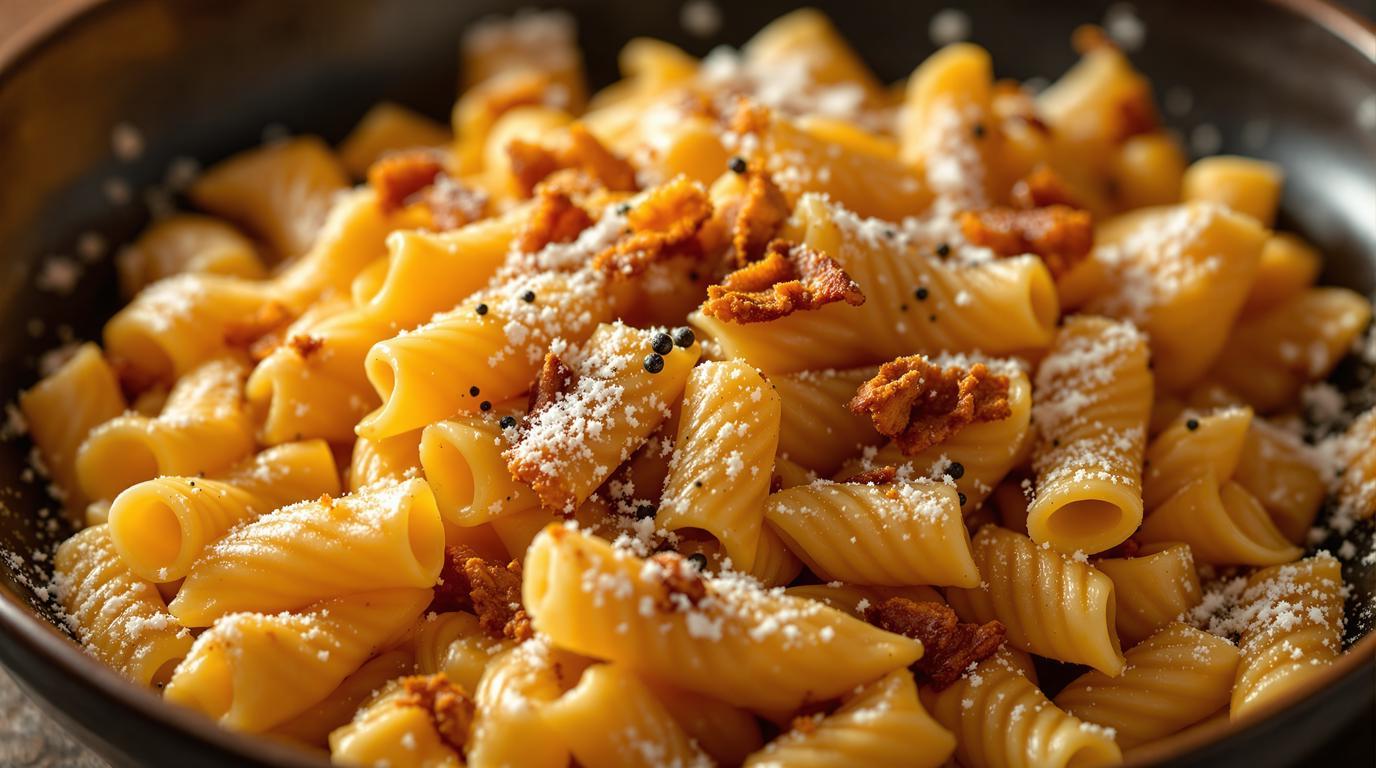There’s something almost magical about the Roman classics—dishes that require only a handful of ingredients but deliver extraordinary flavors. Rigatoni alla Gricia might be the most brilliant example of this culinary minimalism. Often overshadowed by its more famous relatives, Carbonara and Amatriciana, Gricia is actually the ancestor of both, predating them by centuries. The first time I tasted authentic Gricia in a small trattoria just outside Rome, I was stunned by how such simple ingredients could create such profound depth of flavor.
The Soul of Roman Pasta Tradition 🇮🇹
Rigatoni alla Gricia belongs to the four classic Roman pasta dishes alongside Carbonara, Amatriciana, and Cacio e Pepe. Dating back to the 18th century, it originated with shepherds from the town of Grisciano in Lazio who carried preserved pork and aged cheese during their seasonal migrations. Unlike Carbonara, there are no eggs here—just perfectly rendered guanciale, sharp Pecorino, and freshly cracked black pepper creating a silky emulsion that clings to each ridge of the pasta.
During my years working in Rome, I learned that Gricia is often called “Amatriciana Bianca”—white Amatriciana—highlighting its role as the predecessor to the tomato-enhanced version that later developed. This historical context makes every bite of Gricia a connection to centuries of Italian culinary tradition.
The Essential Ingredients 🧾
True Rigatoni alla Gricia demands authenticity in its short ingredient list:
- 350g (12 oz) rigatoni pasta – the tubular shape captures the sauce beautifully
- 200g (7 oz) guanciale (cured pork jowl), cut into ¼-inch thick strips
- 100g (3.5 oz) aged Pecorino Romano, finely grated
- Freshly ground black pepper, to taste
- Sea salt for the pasta water
I can’t stress enough the importance of using genuine guanciale here. It’s not just about authenticity—the distinct flavor profile and the way it renders its fat creates the foundation of the entire dish. Unlike bacon or pancetta, guanciale has a sweeter, more delicate pork flavor and higher fat content that forms the silky sauce base.
Chef’s Note: If you absolutely cannot find guanciale, pancetta is your next best option, though the dish will lack some of its characteristic depth. Never substitute bacon, as its smoky flavor is completely foreign to Roman cuisine. Similarly, only Pecorino Romano will provide the proper sharp, salty balance—Parmigiano Reggiano simply won’t capture the authentic flavor.
Creating Pasta Perfection 📝
The beauty of Gricia lies in its technique. Here’s how to create this Roman classic:
- Bring a large pot of water to boil. Season with about 1½ teaspoons of salt (less than you might typically use, as the guanciale and Pecorino both contribute significant saltiness).
- While water heats, remove any tough skin from the guanciale and slice into lardons about ¼-inch thick.
- Add guanciale to a cold, large skillet, then turn to medium-low heat. Cook slowly, about 10-12 minutes, until the fat renders and pieces become golden and crispy. The slow rendering is crucial—rush this step and you’ll miss the magic.
- Remove about half the crispy guanciale pieces and set aside for garnish. Leave all the rendered fat in the pan.
- Cook the rigatoni for about 2-3 minutes less than package directions indicate for al dente.
- Just before draining, reserve about 1½ cups (350ml) of the starchy pasta water.
- Transfer the pasta directly to the skillet with guanciale and fat. Add about ½ cup (120ml) of the reserved pasta water and vigorously toss over medium heat.
- Remove from heat, add most of the Pecorino and plenty of freshly ground black pepper. Toss continuously, adding more pasta water as needed to create a glossy, emulsified sauce that coats each piece of pasta.
- Serve immediately, topped with reserved crispy guanciale and remaining Pecorino.
The Chef’s Secret Technique 🤫
The true secret to perfect Gricia lies in the vigorous tossing motion Romans call “mantecare”—the marriage of the sauce components through continuous movement. I learned from a Roman chef to use wooden tools and a rapid wrist motion that creates friction and helps the starchy pasta water emulsify with the rendered pork fat and cheese. This creates that signature silky sauce that coats each piece of pasta without becoming greasy or clumpy.
Temperature control is equally crucial—add the cheese when the pasta is too hot and it will clump; too cool and it won’t melt properly. I always remove the pan from heat just before adding the cheese, letting the residual heat work its magic while constantly tossing.
Serving & Enjoyment 🍽️
Serve Rigatoni alla Gricia immediately in warmed bowls. The Romans traditionally pair this with a hearty red wine like Cesanese del Piglio or a younger Montepulciano d’Abruzzo. I find the richness of the dish works beautifully with something bright and acidic on the side—perhaps grilled asparagus with lemon or a simple salad dressed with good vinegar.
Unlike dishes that welcome endless variation, Rigatoni alla Gricia shines brightest when prepared precisely as Romans have for centuries. While you might be tempted to add garlic or herbs, resist the urge. The genius of Roman cuisine lies in its restraint—letting a handful of extraordinary ingredients speak for themselves.
After preparing countless pasta dishes in professional kitchens around the world, I still find myself drawn back to this humble but perfect combination. There’s profound wisdom in these ancient recipes that managed to create something transcendent from just a few ingredients. Whether you’re experimenting with Mediterranean flavors or seeking creative ways to reduce food waste, the philosophy behind dishes like Gricia—simplicity, quality, and technique—remains eternally relevant.
As they say in Rome, “Nella semplicità c’è la perfezione”—in simplicity, there is perfection. This dish proves it with every silky, satisfying bite. Just like my grandfather’s cherished recipes, these traditions connect us across generations, reminding us that sometimes, the most profound culinary experiences come from the simplest combinations.
